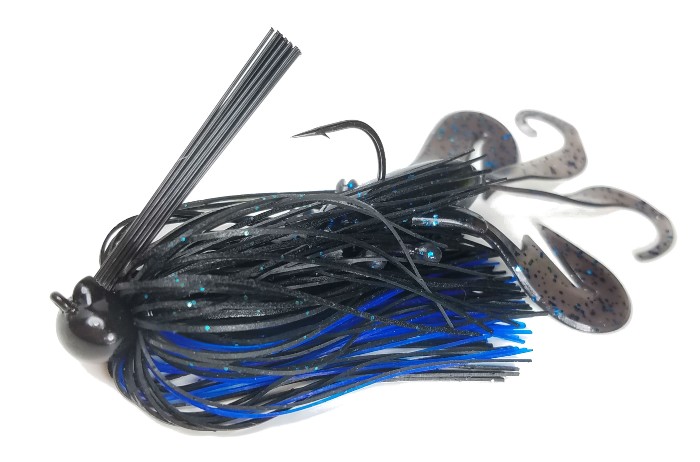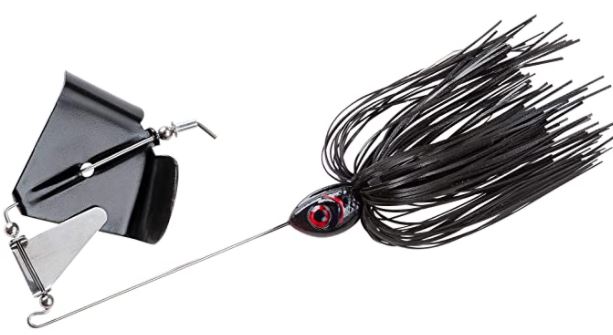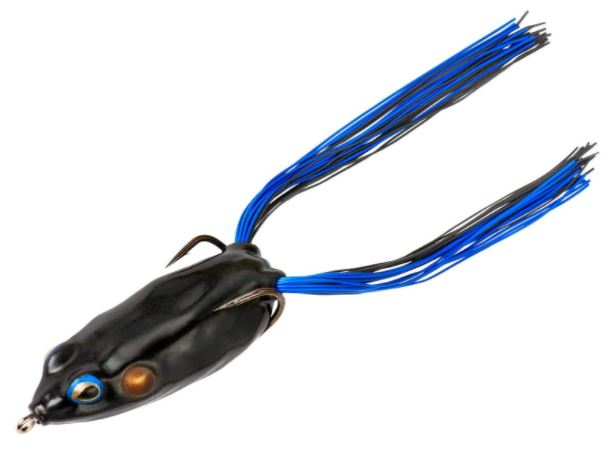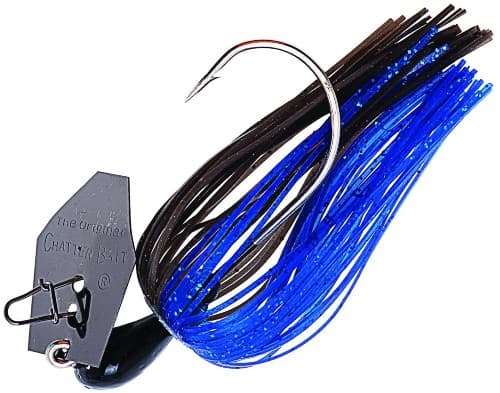Night Bass Fishing Tips | Best Lures for Night Fishing Bass
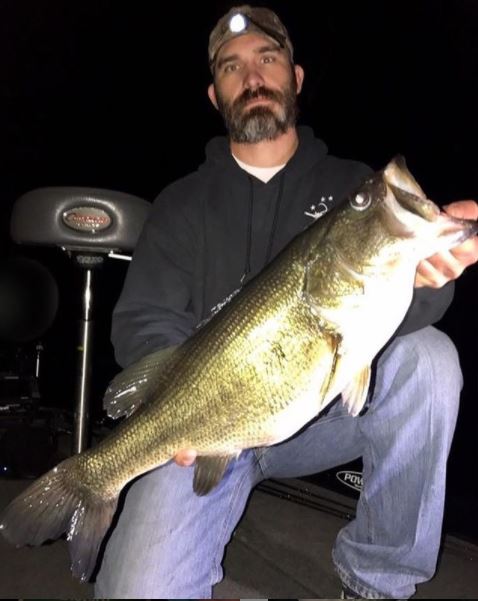
Bass fishing at night is probably one of the most intoxicating aspects to bass fishing, but also takes some time to learn. Fishing in the dark is not for the faint of heart but for those who can master it, hooking up on a monster bass in the middle of the night is what keeps anglers like yourself coming back for more.
Catching bass at night is not very hard. It’s just a matter of being prepared before the sun goes down. All you have to do is stay organized, develop a game plan of what spots you chose to fish, and pick the best lures for night fishing. That’s it!
Key Takeaways
For most anglers you night bass fishing can seem pretty exciting yet somewhat intimidating. Here is a quick and easy to follow list to help you get started fast!
- Preparation before the sun sets is the key to making sure you have everything you need.
- Never underestimate your safety or the safety of others.
- The low light brings out the fatties.
- Understand how to best fish in a full moon or on a moonless night.
- Quickly identify the best spots for night bass fishing.
- Confidently choose the best lures for bass fishing at night.
If you want to learn more simply scroll down into the article below!
The hot and humid months of summer seem to lure in more than just fisherman. Our favorite bass fishing spots suddenly turn into floating trailer parks dodged by jet skis and fishermen galore.
Once the sun goes down though, the lakes tend to take on an eerie quiet, at least on the water.
For bass, the noise and turbulence can cause them to be less active, but once the boats clear out they begin to feed heavily in areas earlier plagued by disruptions.
To cash in on this feeding frenzy, all you need are a few modifications to your gear and some preparations to get things cranking from dusk till dawn.
Get Prepared Before The Sun Goes Down
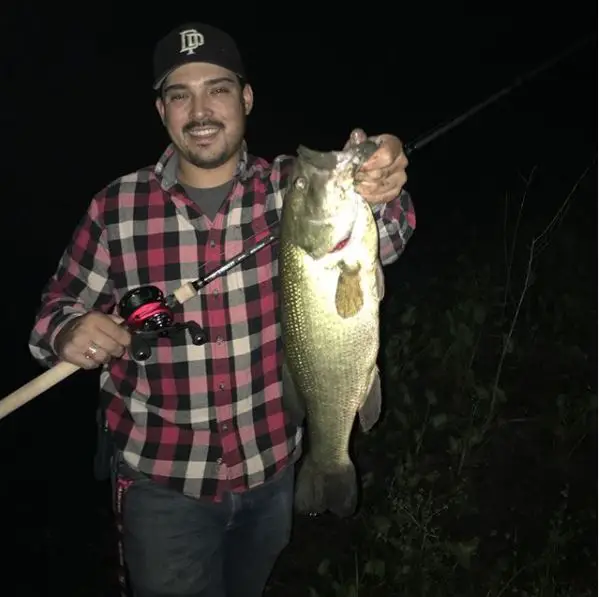
Although you might be tempted to organize a last-minute fishing trip to an unknown destination, don’t… That is dangerous thinking.
It’s important that you know the area well enough to avoid obstacles or getting lost. In an emergency, knowledge of the area could save lives. It can be tempting to mosey along a new shoreline but doing so may put you, your gear, and potentially others in danger. If you want to explore, do it during the day.
First, open up your topographic maps and perform a Google Earth search of all the areas you want to check out.
Then, before you leave for the lake – make sure you tell someone where you are going and what time you are expected to arrive back home.
Then try to arrive to the lake 2-3 hours before sunset. It’s going to be hot, but just do it.
Take the time to familiarize yourself with the place that you’re fishing while it’s still daylight. Make a note of the obstacles that might get in your way, maybe even sketch out a map.
It’s much easier to fish a place that you know well than one that is unfamiliar to you.
Now the fun part begins…
Evaluate each area you plan to fish and make a list of structures that are at that specific spot such as; laydowns, large boulders, submerged timber, stumps, bridge pilings, points, stumps, and humps.
Helpful Tip: If you really want to increase your chances of hooking into a monster bass, make sure to note if there is a transition area (to deeper water) close to the areas you want to fish!
Safety First – No Excuses
Safety during the day is endlessly important, but during the night it’s non-negotiable. Have your PFD’s, know the weather, use appropriate navigation lights, and always be alert and prepared.
Always wear your PFD’s when night fishing. It doesn’t matter how good of a swimmer you think you are. All it takes is one slip and hit to the head and your swimming skills will do you no good.
In the daylight, you can often brace for a collision with objects. During the night, you usually can’t see obstacles coming, leading to a better chance of getting jolted off balance and into the water.
During the night it’s also more difficult to unhook fishing caught on lures with multiple hooks. Take your time and take a seat to do this; there will be less stress on you and the fish.
In the end, being seated when you can is always your safest bet.
Stay Organized – Tackle, Boat, Everything
Another important safety measure is organization. Not only will this lead to a better fishing experience, but it will also keep you in the boat unscathed. Nothing ruins a good night like stepping on a loose hook.
First, keep your deck clear. Make sure you have space to move around without tripping on a net, your tackle box, or the PFD you should be wearing. Before leaving the dock, make sure everything has a place, and think about how you’ll be using your gear to ensure you don’t run into any issues on the water.
Next, think about lights. Have a high-powered flashlight handy for warning approaching motorboats of your presence.
If you’re moving, always have your stern and bow lights on. Before you leave the dock, ensure all these components are working well, and have fresh batteries available.
Finally, have respect for the water and the forces of nature. It’s likely you’ll be one of the only boats on the water, meaning help is not guaranteed.
Learn To Love Low Light
In typical daylight fishing, anglers are accustomed to seeing what they’re doing and watching the line or even the lure, but this is seldom possible at night.
For the most part, intuition and a feel for your tackle become more important at night than during the day. Take advantage of a sensitive rod and line, and throw on heavier tackle to get a better feel for what’s happening.
It’s obviously easier to see on bright, moonlit nights than dark overcast ones. There is still debate over the advantage of bright nights over dark nights for fishing. As anglers we know that areas that receive more light (like docks, piers, and bridges) often have more bait fish, thus more large predators.
Keeping the use of external-source lights to a minimum is a good idea for some types of fishing, though it is unnecessary for others.
Using a headlamp is the best option for times when you just need a bit of light. It’s easy to turn on and hands-free, making it a great accessory for unhooking fish and tying new lures.
Additionally, most headlamps come with subtle colored light options of red or green, which are less alarming to fish and easier for your eyes to adjust to.
Black Light = Visible Line at Night
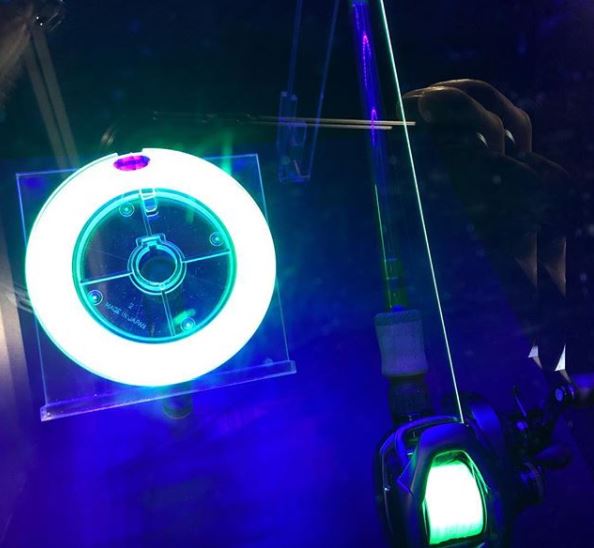
monofilament in black light IG photo cred @jpderoseoutdoors
Spooling on some clear or blue fluorescent monofilament line is considered essential if you’re going be make you’re going be become a night fishing monster.
Under a black like the line will turn a florescent blue color that is easy to see.
But don’t worry, once the line hits the water the blue color quickly dissipates and turns clear again… for many night tournament anglers, it’s their secret weapon.
There are a number of black lights on the market. One of best model tested was the new Nightfishion Plus (nightfishion.net). This completely customizable black-light system attaches onto your boat’s rub rail, making for easy and convenient setup and use.
During the day, it’s virtually undetectable, but with a flip of a switch at night, you get nearly 360 degrees of lighting illuminating every possible casting angle.
A really neat feature is that is has a dimmer switch build in! Now you can adjust the strength or intensity of the produced based on the how bright the moonlight is!
Helpful Tip: Avoid muddy lakes when night-fishing. Clear water with a visibility of 2 to 4 feet is ideal for night fishing for bass.
Rig Several Rods
Setting up a couple of the same rod-and-reel combos that can be rigged with the same (or different) baits can make quick switches easy for those nights the bass can’t get enough of you.
This may sound silly, but this reduces the need to adjust to the “feel” of different rod/reel combos and on how they cast and perform, and if you ever need to re-tie, you won’t have to use your light.
For example, if you’re casting with a bait-casting rig and get a nasty backlash, you can put that rod aside and employ an already-rigged spare one.
Helpful Tip: If the location you’re fishing does not require you to be precise with your casting, then you can use a spinning reel rig!
New Moon or Full Moon Fishing
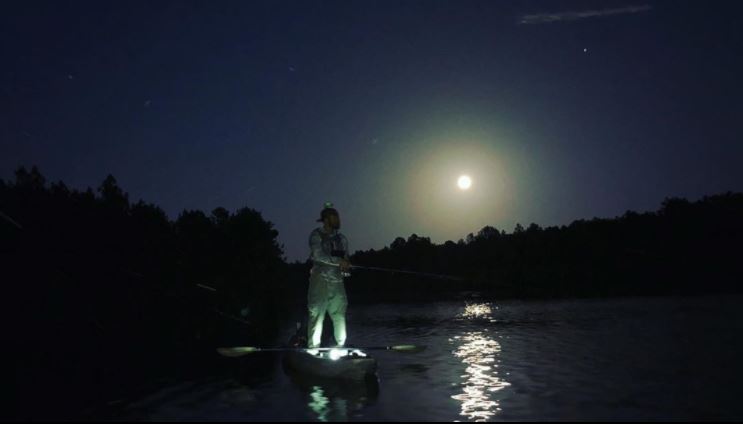
night bass fishing full moon – photo cred @ jay2country
From experience, the lunar phase definitely has an influence on your success. Arguments over fishing a new or full moon are ongoing, but if it’s working, is it wrong?
Helpful Tip: Full moon - the moon is fully illuminated and is very bright. New moon - the moon is on the opposite side of the earth and is not visible at night.
On a full moon, you can certainly see things better, but it also seems to be good for bites. Treat it like a nice morning or evening fish, casting into the “shadows” or areas shaded from the moonlight by foliage.
Many have also noticed that bright full moon the bass will hold tighter to any structure or cover. Whereas, under a new moon bass tend to roam more and willing to commit to a faster moving lure.
Lunar studies have shown that more, and bigger fish are caught under the new moon.
According to a poll we did most angler had to most success three days leading up to, or the three days following the new or full moon are great times to fish.
The full moon’s light is convenient, but if pressed to choose between full or dark/new moon, choose the new moon.
Do You Need To Change Your Lure Color Depending On The Moon Phase?
You bet. Like cloud cover during the day, the amount of moonlight should guide your lure color selection.
Dark nights with little-to-no moonlight you should opt for solid black, brown, or blue. The stark contrast between the lure and the environment makes it easier for the fish to see the silhouette of your bait.
On bright, well-lit nights switch to something bolder. Green/orange or even red/chartreuse are good options to catch the attention of the fish.
On partially cloudy nights, go with black-and-blue, black-and-red, or black-and-brown, sticking to something that looks more solid but can still catch the light.
Best Season To Go Bass Fishing at Night
Mid-summer waters in most of the country are wicked warm, making it hard on fish and fishermen alike. It’s much easier to fish in the spring when temperatures are manageable, and the fish are active and hungry.
Weather
One of the most important factors to consider is the weather.
Consistency is key when it comes to springtime and night bass fishing. And for most anglers, spring will start around later March.
At this time, start watching the day and nighttime temperatures fairly regularly, looking specifically for a couple of weeks with warm days, followed by warm nights.
If you can get out during a small storm, it’s totally recommended. Some of the best fishing nights have come when it’s stormy and breezy.
AGAIN, SAFETY FIRST THOUGH. REMEMBER THIS… If you see any lightning, do not go out into the water!… period, no excuses. Being struck by lightning can lead to serious injury, permanent disability or even death.
If you can get all of those ingredients around a good moon phase, all the better. Aim to fish around the new or full moon, preferably three days before and after.
Keep It Down Son! Noise I mean
Think about it, one of the reasons you’re out at night is because of the daytime noise. Make a point of being quiet and stealthy, especially in a motorboat.
Noise from setting a trolling motor into position, running motors constantly, moving things around in the boat, tossing an anchor into the water; it’s all going to work against you.
You should drift into your area with the motor off, and keep your movements to a minimum. Employ a paddle (without splashing) for getting up close to areas or setting your drift out, and away from obstacles.
Best Spots To Night Fish For Bass
Here is a comparison list that was made specifically for you.
It compares common locations you would find a bass during the day relative to where you would find that same bass at night.
It really puts in perspective how you location strategies need to change once the sun goes down.
| Daytime location | Nighttime location | |
|---|---|---|
| Lily pads | Directly under lily pads. | 3-to-5' feet extending out from the lily pads. |
| Sparse vegetation | Normally not present. | Will been seen cruising through or around these areas. |
| Stumps | Seen close to or hiding in its shadow. | Will be seen cruising through or on the outside edges of a stump field. |
| Submerged weedbed | Seen hiding in pockets or outside edges. | 3-to-5' feet extending out from the submerged weedbed. |
| Docks/ lights/ Marinas | Located in the back of the dock closest to the shore. | Often located halfway out of the dock. If there is a dock light, will position itself on the opposite corner of the light. |
| Points | Seen bunched up in a small area | Will be noted to be more spread out. |
| Fallen trees | Directly under or positioned against larger branches or just on the outside edge of the branches | Often seen suspended 3-to-5' feet extending out from the fallen tree branches. |
Setting Up – Spot Lock It
First, find your fishing spot. Once you find a productive structure such as a good offshore hump or underwater bar, you can be confident the bass will be feeding there after dark.
Then lock in your position using one of two methods.
Method 1) If you have an advanced trolling motor you can now save your spot on your sonar map and it will self-adjust to keep you on the spot.
Method 2) Use a Drift Sock and anchor
Troll past the spot you want and drop a plain anchor off the bow and off the back toss out a drift sock.
Since you won’t be “drifting”, any current nearby will inflate the drift sock and ‘pin’ your boat to the exact spot, giving you optimal casting angles.
Helpful Tip: Once you’re anchored, fish for at least 20 minutes without a bite before moving. Each night, try to spend time exploring and looking for new spots. But the best action generally occurs when we're anchored.
Why not just use the trolling motor all night along?
Big bass prowl edges looking for easy prey, so your baits should be there when they come to eat. At other times though, bass may be holding on a spot when you arrive, and they’re spooked by the noise of the boat.
When you anchor and wait, they resume feeding, although it may take 10 or 15 minutes for them to settle down.
If you were fishing along with the trolling motor, they’ are going to get spooked and be long gone!
For this reason, you need to try to create as natural of an environment as possible—turn off sonars and lights and sit quietly.
Ringing The Dinner Bell
How to bass fish at night!
As the daytime temperatures rise, bass start moving off high points, ledges, and submerged islands into the cooler, deeper waters. As the day cools, they gradually start moving back up into the shallows.
As they move, greet them with really loud, bold lures.
Nothing builds more jaw-dropping excitement than having a giant bass smash your lure in the middle of the night, and if the conditions are right, baits that cause the most commotion, have the loudest sound or give off the most vibration will give you those bone crushing strikes!
Having a huge lunker bass smash your jig or spinnerbait is worth all the time and preparation you made to make the night successful.
Best Bait For Night Bass Fishing
As the daytime temperatures rise, bass start moving off high points, ledges, and submerged islands into the cooler, deeper waters. As the day cools, they gradually start moving back up into the shallows.
As they move, greet them with really loud, bold lures.
Nothing builds more jaw-dropping excitement than having a giant bass smash your lure in the middle of the night, and if the conditions are right, baits that cause the most commotion, have the loudest sound or give off the most vibration will give you those bone crushing strikes!
Having a huge lunker bass smash your jig or spinnerbait is worth all the time and preparation you made to make the night successful.
Fishing Jigs At Night
Crayfish are nocturnal feeders and come out en mass at night.
If you’re around rocky structure fishing a jig is deadly nighttime, especially when pair with a fat chunky trailer.
Remember, a jig imitates all the natural actions of small forage fish like shad and even crayfish.
Therefore, fishing with a 3/8-1/2 football jig best mimics this creature.
Helpful Tip: If you notice the bass are crushing shad thread on a soft plastic swimbait immediately… you’ll thank us later.
Colors you need to go to are black-and-blue, black-and-red, black-and-brown or green-brown (depending on how bright the moon is).
Pair the jig with a Yamamoto Double Tail Grub, or Rage Tail Craw; you really can’t go wrong with either of those trailers as they both give off a ton of vibration.
Black-and-blue, black-and-red, or just all black in color.
if the wind starts to pick up and they still won’t come up for a frog, you can opt to swim the jig over. If the jig isn’t already trimmed, leave the skirt full. Like using a solid colored lure, a full skirt creates a more definitive silhouette, making it easier for big bass to find your bait.
I strongly recommend using the Rock Crawler Tungsten jig. Tungsten not only presents a smaller/ less threatening profile, but is significantly more dense than soft lead. This means you can instantly feel changes in bottom structure or detect the slightest of bites.
Read more: Check out all the reviews from real Amazon customers!
Buzzbaits
If the lake you’re fishing has a breeze to it, it should sound an alarm in your head to throw a buzzbait.
Fishing buzzbaits at night can be an absolutely amazing lure to throw and catch a TON of fish.
Also add a trailer-hook and soft plastic bait to prevent short strikes.
This will help with short-strikes and will also add weight to the bait for longer casts. It’s crazy fun watching a big bass slam your buzzbaitt gurgling slowly down a windy bank.
Clamping the rivet down on your buzzbait blade will add more squeak and squeal. You can also bend and tweak the blades in a bit, forcing the bait to slow down in the water.
There are several different styles of buzzbaits. However thousands of anglers and professionals alike recommend using a buzzbait with a loud clacker. The clacker creates additional sound the bass can hone in on and will get you gigantic topwater strikes.
Frogs
Topwater frogs are one of the best bass baits to use at night. The sound of a topwater frog getting engulfed is about the coolest sound out there.
Some nights they just won’t come up for one, other nights you can’t keep them off. When throwing a frog at night, color really doesn’t matter too much…
A black frog should be your first choice, but you can also catch them on a green frogs as well.
Where to fish a frog at night?
Fishing frogs at night is different from the daytime approach. Instead of fishing the frogs over vegetation, frogs are best fished as a topwater walking bait.
Fish the frog alongside grass mats, in open water over points, or beside docks to give you a few ideas.
What is the best frog lure?
Popping-style frogs tend to be best for big bass at night. I recommend that Booyah Pad Crasher.
The popping action is just like a large Rebel Pop-R. It’s long enough you can walk-the-dog with it. A really nice feature is that it doesn’t fill up with water on every cast. Lastly, the Booyah Pad Crasher is roughly half the price of other popping frogs.
Read more: Check out all the reviews from real Amazon customers!
Frog Modification Tips
Frog fishing modifications, tips, and tricks to catch more bass
Another hack to make your frogs work more efficiently is to insert a glass rattle or two.
All you need are a couple of glass rattles, then make a small incision in the belly of the frog. Use a razor blade to make a small clean, smooth cut. After inserting the rattles, add a touch of superglue—give it a few minutes to dry and your good-to-go.
Doing this allows for longer casts and added noise to give big bass something to hone in on when you’re out on those super dark, windy nights.
Helpful Tip: Switch to a swim jig or large soft plastic swimbait and sim them parallel the grass line. You can also hog a jig or large worm parallel to the grass line.
The best frog fishing setup should include the following
- Rod type: Baitcasting rod – heavy power.
- Length: 7-to-8 feet in length
- Action: Extra fast
Spinnerbaits For Night Bass
One of the best ways to cover water quickly is to use a spinnerbait, especially if the area you are fishing has surrounding structure.
However, not all spinnerbaits work well at night. You’ll be surprised to know what makes a good night time spinnerbait.
Size – The size of the spinnerbait should be 1/4-to-3/8-ounce. In general try the keep the bait higher in the water column, unless you intentionally try to bang it into a submerged piece of structure.
Blade type –
Colorado: the is the most popular style night fishing spinnerbait blade, and for good reason. By far and away produces the most “thump” and vibration that bass can key in on.
Indiana: This is a great blade to arm your spinnerbait with, especially if it’s a full moon and the bass can see your lure a little easier.
Willow: This blade is the go-to for daytime fishing, not so much at night.
Skirt color – The color of the skirt depends on the moon phase. The brighter the moon, the brighter the skirt colors. The darker the night, the darker the colors.
If the night you’re fishing is nearly pitch black, then go with a black and blue skirted spinnerbait. If you have anything more than a half-moon, the you may want to consider adding some bright florescent colors mixed in with a black skirt material.
The best spinnerbait fishing setup should include the following:
- Rod type: Baitcasting rod – medium to heavy power.
- Length: 6’7”-to-7’8” feet in length
- Action: fast
Nichols Lures Pulsator Spinnerbait uses Extreme Flash Technology (EFT) to create a holographic light pattern that makes these the flashiest, brightest blades on the market. Fishing lures with the realistic hand-painted head with flared gill plates. Tournament grade components make our spinnerbaits made to last. Stainless steel spacer with 90 strands, 100% silicone hubbed skirt with built-in necktie trailer. Made in the USA
Read more: Take a look at what other fishermen just like you are saying about the Nichols Pulsator Spinnerbaits
Bladed Swim Jigs
Bladed Swim Jigs like the Z-Man Chatterbait, or bladed jigs give off a ton of vibration, which makes them an excellent bait for night fishing.
The blade in front of the jig displaces the water giving bass something to hone in on and attack. It also goes through weeds pretty well, which helps at night where weed lines are a little harder to see.
Again, go with black and blue, or a dark color and use a bulky trailer like a Gary Yamamoto Zako. The bigger the profile, the better.
The best rod for chatterbait/bladed jig
The rod reel setup should include the following:
- Rod type: Baitcasting rod – medium to heavy power.
- Length: 6’7”-to-7’8” feet in length
- Action: fast
Reel: baitcasting reel – moderate-high speed at least 6.1:1
Helpful Tip: What to do if you’re fishing Chatterbait-type lures and the bite stops? Switch to a jig, or a curly-tail or a wacky-rigged worm and flip it to a specific spot of structure (typically the “shadow side”). You can also slowly swim large soft plastic swimbait or cast a wide wobbling crankbait and bump into that structure
Night Fishing With Swimbaits

Most anglers disregard a large swimbait as being a great night fishing lure, but that is not true at all.
Even though swimbaits are silent, it’s not the sound that attracts the fish. It’s with their sheer size and thump of their tail is what attracts the bass.
Swimbaits are also very natural appearing which further intrigues the bass.
Size – larger size swimbaits will displace the most water, so opt to throw a bait that is 5-to-7-inches in length.
Don’t be afraid to throw big bulky baits.
Color – Doesn’t seem to make any difference. however, the best night time swimbaits are the ones that are opaque.
Retrieve – Slow and steady. The slower the better. Make sure it bumps and grinds into the bottom structure.
If you want to pop your rod tip every now and then it’s fine, but let the swimbait sink to the bottom and start your grinding retrieve again.
Crawl Large Baits
Large worms or large creatures (beaver style baits) can offer bass a big meal that they’ll often prefer. To a fish, the less energy they have to expend for a meal, the better.
You can fish large baits Texas or Carolina rigged. Use a tungsten weight to have a better feel for the lake floor composition. Another bonus of using tungsten is since it’s smaller, you’re less likely to get hung up!
Helpful Tip: What if you're fishing jigs or crawling large creature baits and the bite stops? Switch to using a crankbait or a large soft plastic swimbait bumping into the structure below. If you “hop” swimbait like you would a jig, you’ll often be surprised on now many strikes you’ll get!
FAQ
Do fish like glow in the dark lures?
To name a few, pike, crappie, and trout all seem to respond positively to glow-in-the-dark lures. Bass, not so much. Saltwater species also are attacted by glowing lures.
Do I need to bring a net for night fishing?
Yes, absolutely. A big oversized net is essential for allowing you to quickly and easily bring in the fish without having to risk slipping and falling into the dark water.
Is night fishing legal?
In most states night fishing is legal unless otherwise posted. Please check with your game and fish department. If you’re fishing on private property always ask permission first.
Can you night fish from a kayak?
Yes, but you must be incredibly careful and use the same precautions just like you were in a regular boat. Always wear your lifejacket when you’re night fishing.
In summary
I hope that you don’t mind that I over-delivered. I just really wanted to give you the best blueprint on all ways to fish for bass at night and how catching bass at night can be fun and exciting. Just remember to stay organized, stay safe, chose your spots wisely, and always pick the best lures for night fishing.
Take care and Tight Lines.
Top picture photo cred: @lakeforkguide_whitt_smith
Other Night Fishing Related Articles Listed Below!
Checkout These Other Summer Fishing Articles...
- Complete 5-Step Formula For BASS FISHING DOCKS
- The 7-step Secret Formula for BASS FISHING LEDGES – Even a Complete Fishing Noob Can Use and Be 100 Times More Potent Than the Best B.A.S.S. Professional!
- Top 25 Summer Bank Fishing Tips (Never Get Skunked Again)
- Bass Fishing In Heavy Grass? [17+ Mistakes To Avoid]
- 7 Top Secret Weedless Bass Lures for Flipping into Heavy Grass -Exposed!
- How To Fish A Crankbait [TOP 10 Essential Secrets To Catching Bass With A Crankbait]
- 15 Best Deep Diving Crankbaits [2023 Buyers Guide – Which to Buy & Avoid]
- Fish a Flutter Spoon The RIGHT way... like the Pros... And Do It TODAY!
- NEW and truly "no brainer" (yet usually overlooked) way to MASTER SOFT PLASTIC PADDLE TAIL SWIMBAITS and increase the amount of bass you catch 100% or more... automatically!
- Top 5 questions and challenges every about hair jig fishing... AND how to overcome common problems most anglers encounter (and then prematurely quit).
- Top 10 Best Jigs For Bass Fishing [Insiders Only]
- Avoid this ONE Texas rig fishing NIGHTMARE - And increase your Texas rig fishing expertise FAST!
- 31 Best Tips for Bass Fishing At NIGHT (Complete Guide)
- 2023 Buyers Guide Best GREEN FISHING LIGHT [LED FISHING LIGHTS Reviews & Tips]
- Dock Lights For Night Fishing [Best Products, Secrets, & Tips]
More articles just for you...
Selecting Early Summer Bass Fishing Lures [Avoid 5 Common Mistakes]
A Complete Buyer’s Blueprint On The Best Early Summer Bass Lures On The Market Today! When it comes to bass fishing, choosing the right lure
Early Summer Bass Fishing [Avoid These 3 Sneaky Lies]
Learn these closely guarded secrets early summer bass fishing … and… dramatically boost your advantage over other anglers! Late spring to early summer bass fishing
Fear The Finesse? 7 Ned Rig Fishing Secrets Exposed!
Conquer the Fear of Finesse… and… Unlock the Potential Ned Rig Fishing – TODAY! Fellow Angler… Like most of you I’m pretty set in my
Fishing Spawning Bass [18+ Lures & Gear]
Get Ready For The Spawn Now When bed fishing, stealth is of the biggest essential tip. Instead of racing forward with a trolling motor, anglers
[2024 Editors Choice] Picking The Best Bass Fishing LINE For ANY Budget
What is the best bass fishing line? | What is a good fishing line for bass? The best type of bass fishing line is based
Drift Sock Basics – What It Is A Drift Sock & How To Use It [2024 Quick Start Guide]
What Does A Drift Sock Do? | Why Use A Drift Sock? photo cred: WLUK We’ve ALL been there… you work your butt off the

